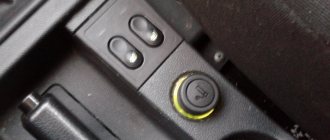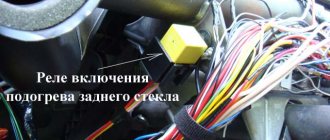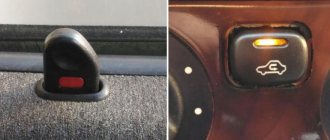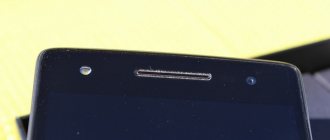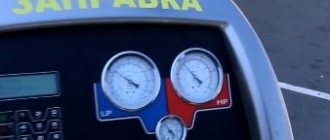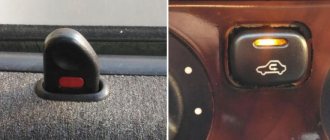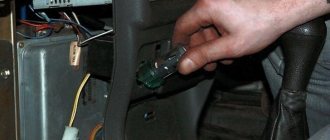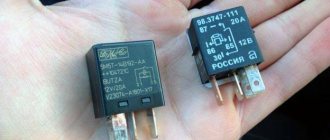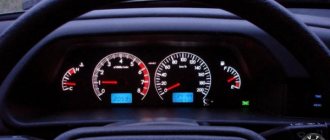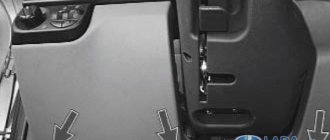Design and principle of operation
The design of the cigarette lighter is quite simple. Inside the metal cartridge is a nichrome spiral that heats up. The cartridge is inserted into the cigarette lighter socket, located in different places in the cabin. When you press the handle, the contacts close, as a result of which the spiral begins to heat up. After the heating has reached its maximum point, the thermal relay is activated and the device snaps back to its original position.
The circuit voltage is 12 volts. Therefore, it is not recommended to connect more powerful devices to the cigarette lighter socket. This will cause overheating and blown fuse.
The device itself comes with three wires:
- black – minus or mass that comes to the car body;
- red – responsible for the voltage of the heating element, connected to the positive terminal of the battery through a fuse;
- yellow – backlight wire.
Connection diagram
Connecting the cigarette lighter is not difficult. The device is connected to the on-board network with only three wires.
- Black wire - the ground of the car is connected to the cigarette lighter body.
- Red wire – power is attached to a terminal at the end of the housing. This threaded clamp also serves as a fastening for the heater retainer, so power is supplied to it as well.
- Yellow wire – power supply for instrument lighting is connected to the lamp socket. Ground, which is supplied through its contact with the cigarette lighter body.
VAZ 2104-07
Functions
In modern society, it is not so much the cigarette lighter that is important, but its socket itself. It is into this hole that other electrical devices are inserted, without which many car enthusiasts simply cannot do without. In simple terms, a socket is a so-called socket, but not in a house, but in a car. With it, you can charge your cell phone, connect navigators and radars, and also use a mobile car wash. Every year the market is replenished with newer, more diverse car accessories and gadgets that run on electricity.
The cigarette lighter is a simple device, but even in its operation, incidents and malfunctions can occur. This article describes all possible problems with the cigarette lighter, as well as troubleshooting methods for different car brands.
What not to do if the cigarette lighter in your car stops working
Burnout of the heating element is a rather rare occurrence today; other breakdowns are much more common. This is due to the growing popularity of a healthy lifestyle. But the main reason is that we use the car cigarette lighter for its intended purpose - we charge our electronic devices.
Of course, the heating element can be changed. This is what they used to do on Zhiguli cars. However, in the modern world there are so many different cigarette lighters for a car that it is much easier to change the system completely than to select individual elements of permanent and removable parts.
Burning of contact areas is a common failure. The reason is high currents (up to 25 Amperes), which often flow at the moment of switching.
Never clean contacts with a knife or screwdriver. Most often, power is supplied to the car cigarette lighter constantly (sometimes in position 1 of the ignition key). If you clean it with a non-insulated metal object, you can short-circuit the supply voltage to ground. In this case, the fuse will blow.
It is better to clean the contact area by first de-energizing the cigarette lighter. Alternatively, remove the appropriate fuse. Clean with a screwdriver tightly wrapped in sandpaper. You can also treat the contacts with a hard brush dipped in alcohol. To prevent fire, allow contacts to dry.
Untimely release of the removable element from a temperature that has not reached the operating temperature can occur if the bimetallic plates of the retainer are worn out.
This often happens if, after installing unsuitable electrical appliances and adapters, the geometry of the plates is disrupted. The plates gradually unbend and hold the cigarette lighter element in the wrong position. Premature release occurs.
Basic faults
The cigarette lighter has never been a completely reliable electrical connection. This was not provided for by its design itself - it is not designed for long-term switching of large currents. Only an increase in the number of presser feet can ensure good fixation of the consumer plug in the cigarette lighter socket. But alas, there is no uniform standard for such a connection today.
In reality, aftermarket forks only have a spring-loaded center contact and a pair of weight clamps. The location of the central contact area in the socket may or may not be quite deep. The location of the presser foot slots may not be where they are located on the fork. To switch large currents, the cross-section of the contacts themselves is not enough.
Due to various shocks and vibrations while driving, the plug and socket of the cigarette lighter lose reliable contact, the connection may spark, and there may also be a short circuit. Since in modern cars the cigarette lighter socket is usually used as a socket for connecting a large number of other devices, all kinds of tees and splitters are used here, which also cannot by themselves add reliability to the device.
Let's summarize and say that trouble-free operation of a car cigarette lighter is only possible if the use of the latter is reduced to its intended purpose - heating the insert spiral and lighting cigarettes. Otherwise, sooner or later you will encounter one of the malfunctions that we will discuss below.
The head does not fit into the cigarette lighter socket
It often happens that drivers complain about poor fixation of the cigarette lighter in the socket. Agree, holding the cigarette lighter in the socket until it is completely warmed up is quite tedious and unsafe, especially if you are driving a car. The reason for this malfunction lies in the “wearing out” of the antennae in the socket, after which they simply no longer hold the cigarette lighter. This problem can be resolved quite easily: you need to bend the antennae a little.
Cigarette lighter head coil burnt out
The reason that the cigarette lighter has stopped working may be a burnt-out coil on the cigarette lighter itself. In this case, replacing the cigarette lighter head with a new one will help solve the problem. If you cannot find the part you need, you can carry out a simple repair yourself - clean the head spiral from carbon deposits and soot.
This is interesting: Reasons for the appearance of oil on spark plugs, solutions
If you follow the rules, the spiral of a standard cigarette lighter should heat up to red and snap out 20 seconds after switching on. If it does it faster or slower, you can adjust the time by bending or bending the cigarette lighter contacts. If the adjustment does not produce results, you can solve the problem by replacing the part.
Cigarette lighter fuse blown
A fuse blown often occurs due to the fault of the motorist himself, who likes to connect many additional devices via a splitter. Thus, an increased load is placed on the cigarette lighter, and since, by its characteristics, this device is designed exclusively for a certain power, as well as only for short-term switching on, and not for systematic use, the fuse simply cannot withstand the heavy load and burns out.
This problem has a solution, although it is not without risks: you can use a more powerful fuse, but this may lead to the burning of the entire socket. To prevent the fuse from blowing, as well as the cigarette lighter socket, experts do not recommend connecting many devices to it through splitters, and it is strictly forbidden to connect devices to the cigarette lighter whose plugs are not assembled tightly or are loose - in this case, a short circuit may occur and many additional problems may arise.
Broken wiring
Another malfunction in which the operation of the device will be disrupted is a break in the wiring. As a rule, the wire may fray in some place or get pinched, as a result there is no contact and the cigarette lighter does not work. You can check for this malfunction (open circuit in the wiring) using a digital multimeter that has a wiring test function.
Only replacing the wiring can solve the problem. In order to avoid problems with electrical wiring in the future, you need to remember some simple rules. Firstly, in no case should you connect a radio or similar power devices to the cigarette lighter - they must be connected directly to the battery. Secondly, ensure high-quality insulation of all wires, since sparks due to poor insulation can lead to a car fire. Be extremely careful and attentive!
Causes of failure
Next, we will look at why the cigarette lighter in the car does not work. There are only a few of the most common reasons for the failure of this device:
- blown fuse;
- burnt out cigarette lighter socket;
- wiring break.
Most often, people face the problem of a blown fuse. This incident occurs both in domestic cars and in foreign cars. The culprits are most often car gadgets. The operation of the cigarette lighter is designed for a certain power, and very often car owners connect devices that exceed the permitted value into the hole, causing the fuse to blow.
The solution is quite simple - replace the blown fuse and henceforth use the connector only for low-current devices. Powerful devices should be connected directly to the battery. Although this is inconvenient and sometimes not so simple, it is much safer and more effective.
Advice! If you often use powerful devices, but do not have time to connect to the battery, then you can output an additional connector with a power socket that connects directly to it.
Another reason why the cigarette lighter does not work is a short circuit in the device socket. This happens when dangling or non-standard plugs are inserted into the socket. You should also not install more powerful fuses - this will definitely lead to a short circuit. If such a misfortune does happen to you, then the only correct solution to the problem is to replace the socket.
If the cause of the breakdown is not a burnt fuse or socket, then it is worth checking the cigarette lighter wiring for integrity. Perhaps there is no current due to a broken wire. It should be soldered and all connectors checked - they should be inserted tightly.
Every second driver at least once in his life wondered why the cigarette lighter stopped working. Therefore, the issue of self-repair of a breakdown is very relevant.
Other problems at work
Unfortunately, there are a number of other reasons why the cigarette lighter in a car does not work. They are all different and each car brand may have its own.
Many Dodge Caliber owners also face the problem of a non-working cigarette lighter. Most often, the device breaks down while another device is working in it, and smoke begins to appear from the panel. This happens due to overvoltage generated by more powerful devices connected to the connector. In this model, such a breakdown can lead to problems in the operation of other devices, since the burnt wire is located in the common harness of others. You won’t be able to solve this problem on your own, because you will have to remove the entire front console. Such a breakdown can occur repeatedly, so it would be best to install a fuse in the cigarette lighter itself.
On domestic brands of cars, incidents in the operation of the cigarette lighter also often occur. Of course, most often fuses blow due to improper use of the device connector. It is quite simple to check why the cigarette lighter on a VAZ 2110 does not work. Turn on the stove fan - if it does not work, then the reason is fuse F18. The fact is that these two devices operate from one fuse and its blowing leads to the failure of two devices at once. To replace it, you do not need to go under the hood; it is located to the left of the steering wheel in the fuse box. However, if the fan is working, then you should not immediately blame the wiring. You need to check the fuse, which is designated F6. Few people know, but it also affects the operation of the device and perhaps the reason is precisely its burnout.
Cigarette lighter repair
To successfully troubleshoot the problem, you first need to determine why the cigarette lighter does not work. To do this, remove it from the socket and use a test light to check whether there is electrical power on the heater latch and whether there is ground on the body. It is better to do this with a control unit, because, unlike a voltmeter, it consumes current. Therefore, in the case of oxidized contacts, it will glow only at full intensity or will not light up at all. The voltmeter readings in this case will not differ from those taken from a working device, since in the absence of current there will be no voltage drop across the resistances of the oxidized contacts. Below we describe several variants of the results of this test.
- The control lamp connected to the body and heater retainer glows brightly. This means that the socket is working properly and the fuse is intact. Most likely the heater coil is faulty. In this case, check its resistance with an ohmmeter, which should be about 1 ohm. If the measuring device shows an infinitely high resistance, this means that there is a break in the spiral. If the heater burns out, there is nothing to do; you need to change the cigarette lighter in the car. In this case, its nest can be left the same.
- The control does not light up when connected to the socket. Maybe the fuse has blown. If the fuse link is intact, check for corrosion on the terminals. And are the power and ground wires broken? If the fuse is blown, replace it with an insert of the same rating. This may be because you connected a device that draws too much current to the jack. If, when installing a new fuse, it blows, it means the power circuit is shorted to ground. Disconnect the positive wire from the socket. If the insert no longer fails, then there is a short in the socket. The fire protection may have activated. Then either change the nest or repair it. To repair, remove the nut from the power terminal and remove the fusible jumper. Make the missing washer from tin-lead solder and assemble the assembly. Don't forget to install an insulating spacer under the homemade washer.
Diagnostic measures
Situations where cigarette lighters do not work on cars are not as common now as they used to be. But still, such a breakdown is quite likely.
In this situation, you need to understand the reason why the malfunction occurred. Depending on the diagnostic results, the motorist will have to carry out the appropriate work to correct the problem.
Diagnostics may include the following activities:
- First, you should carefully check all connections and make sure that no wires have burned out. Here you will have to perform partial dismantling of the unit.
- Check for damage to the wiring on the cigarette lighter body and how firmly they are connected.
- Be sure to open the fuse box where the element responsible for the cigarette lighter is located. It must have a corresponding label or inscription.
- Make sure there are no signs of burning or signs of clogging of the socket itself or its contacts. Quite often, when foreign objects enter, the system’s performance is disrupted.
- Assess the current condition of the socket plug.
One of the most common problems is a blown fuse. On many cars, this is responsible for several systems simultaneously, including the cigarette lighter.
This means only one thing. If the fuse element is blown, then power will not be supplied not only to the cigarette lighter, but also to other systems with which it is connected. The simultaneous failure of several systems in a car most likely indicates problems with the fuse.
This is interesting: Symptoms of a malfunctioning throttle position sensor and how to check
But fuses don't just blow. Therefore, it is also worth understanding why the burnout occurred and how to avoid repeating a similar situation in the future.
Checking with a multimeter (or tester)
This means that they can test both fuses that have already been removed and those installed in the machine block.
The multimeter has a sound test mode. When you turn it on, if you close the probes, you will hear a squeak, which means there is contact.
So - you can remove the fuse, if you do not have a transparent case, just install the probes on the fuse contacts! If we hear a squeak, it means it’s working; if there’s no sound, it means it’s burned out. But again, pulling out each one and checking it is extremely inconvenient!
Therefore, the manufacturers took care of us, on the top of the fuses there are open “points” from the contacts, you just need to insert the probes from the multimeter into them, and you can check a large number of elements without removing them. Personally, I can check almost the entire block in a couple of minutes! You can see this in the video below.
This is exactly how they test at service stations, because often they lost the book with the circuit, and it takes a long time to find where it is, but a multimeter is usually always at hand.
Physical examination
At the moment, all fuses are made with a transparent plastic case, that is, the “thread” located inside is visible to the naked eye. If the fuse is blown, simply pull it out of the connector and check, this is the “visual method”!
Why is it complicated and not always used - yes, because there are dozens of fuses in modern cars (can reach up to 30 - 40), and the cooler the car, the more there are. And it’s visually impossible to figure out which one burned out!
They are installed in sockets and only the back is visible. Here you need to combine a diagram (the first method) and a physical examination. But there is a much faster and fairly easy method of checking, we use a multimeter if you have one.
Schematic check
What it is? If any device does not work for you, for example a cigarette lighter, there is a high probability that it is the safety element that has burned out. For each car, there are diagrams that indicate what and which one is responsible for. You need to find the number or location and check it, often this is enough. The check could be like this: we simply install a new one, if it works, then that’s the problem.
Replacing the cigarette lighter yourself
The most common and minor breakdown in a car occurs due to the cigarette lighter. Many car enthusiasts who don’t even smoke face this problem, because modern devices used in the car are all charged from the cigarette lighter. This includes a telephone, a navigator, a recorder, an electric pump, refrigeration equipment and much more that is needed on the road.
With so many necessary things, the cigarette lighter often fails, so it must be handled with special attention. But if it does break, then how to solve this problem? Let's take a closer look at this.
Worth remembering before work
You need to remember that fuses are in the electrical circuit, so you need to take precautions:
- The car must be turned off
- The ignition must be turned off
- The battery must be installed and the terminals must be connected, otherwise there will be no “power” to the electrical circuit
- Do not bridge the contacts of one fuse with another using a multimeter.
What I would like to add in conclusion, guys - the first two methods are available to everyone, that is, it’s trivial to pull it out and look, but the third one with a tester... buy it, it’s a really useful thing in the car, if you decide to figure it out yourself, we just can’t replace it!
Step-by-step guide to replacement and setup
Below you will find information on how to remove the cigarette lighter, how to understand its circuit, perform installation, and also how to disassemble the cigarette lighter.
Tools and materials
Installing and replacing the cigarette lighter requires the presence of some tools:
- pliers;
- file;
- Screwdriver Set;
- soldering iron
You can learn how to connect a cigarette lighter from the author of the video, Dmitry Maznitsyn.
Troubleshooting Methods
If the cigarette lighter stops working, it is necessary to carry out proper diagnostics. For this operation, you only need a multimeter set in tester mode, or a homemade device constructed from a lamp and several wires.
For the most part, this device is located in the mounting block in a special compartment of the machine. To get to this device, you will have to open the hood and in the mounting block - in the black box, which is located in the far corner, find a fuse, which can be called either F4, F7, and sometimes 20 A - it all depends on the maximum current for which the fuse is designed .
In order to diagnose the fuse, you need to remove it and connect it to a multimeter to test the contacts. If the lamp on a homemade tester lights up, or the device emits a sound alert indicating that the fuse is intact, then the problem lies elsewhere.
This is interesting: Why do hydraulic compensators knock when cold or hot?
Important: you should not install the rated current next to the fuse, because this will lead to irreversible consequences, possibly even a fire.
One of the causes of the malfunction may be the driver’s inattention when working with auxiliary devices. For example, after recently cleaning the car interior using electrical equipment, the cigarette lighter in the car does not work - this means the problem is in the fuse. To avoid these problems in the future, you need to carefully control the current supply.
Sometimes, if the cigarette lighter and the radio are not working at the same time, you may not find any connection, but it is there. After all, it also happens in everyday life when a driver connects the radio contacts to this device, because it’s easier than going the other way and connecting to the car’s battery. Thus, when it burns out, the stereo in the car stops working at the same time. In this case, it is better not to self-medicate, but to go to an auto center and consult a qualified specialist.
It happens that drivers install a lot of equipment in the car, although it is more correct to connect it to the battery.
If the methods described above do not solve the problem, all that remains is to check the wiring for corrosion.
- Particular attention should be paid to connecting the positive wire and ground wire to the device.
- Inspect all connections and, if contacts are loose somewhere, restore them.
- Check the contacts of the wire block on the mounting block.
- If there is a break in the wire from the block, it is necessary to replace it locally, or replace the entire harness.
Work sequence
You can learn how to change the cigarette lighter from the instructions described below.
- Disassemble the system only after de-energizing the vehicle. If the driver pulled out the cigarette lighter while the wires were connected, this could lead to a short circuit and even a fire, then the installation will not seem easy.
- When removing the device, you must be careful. When working, you need to use a small flat-head screwdriver. It is placed inside the part. Use the end of a screwdriver to press on the green latch and unscrew the sleeve. Then remove the glass part.
- Remove the device and carry out repairs. The installed device is placed in its original place. When connecting contacts, correct polarity must be observed to prevent short circuits.
Detail on a car dashboard
How to remove the cigarette lighter
If you have found the cause of the cigarette lighter failure and prepared the necessary equipment, proceed to disassemble the part. The dismantling process involves the following steps:
- First you need to open the hood and remove the negative terminal from the battery.
- Next, you need to disassemble the facing panel to gain access to the socket connection connector.
- Then you can unscrew the screws and disconnect the block.
- The next step is to dismantle the metal cigarette lighter tube using a screwdriver.
- After removing the part, you must turn off the backlight.
A serviceable element can be repaired, but a burnt-out element will have to be replaced.
Car cigarette lighter button repair
Often the device stops working due to damage to the power button.
The problem is solved by dismantling the failed key and then restoring or replacing it.
The repair process does not take much time and is done with your own hands.
Cigarette lighter head repair
In some cases, it is necessary to perform partial repairs of the car cigarette lighter. To do this, the element is dismantled according to simple instructions and checked for defects under the housing. Inside the part there is a miniature mica plate, which acts as a semiconductor and often fails. The product must be removed, repaired, and then put back.
How to disassemble the cigarette lighter on a VAZ?
Before unscrewing the nut on the back and proceeding with complete disassembly, remember, or better yet, photograph the position of the contacts. This will greatly alleviate possible difficulties during assembly.
And now you can begin to completely disassemble the device. You will need to unscrew the nut, then bend the metal parts away from the plastic. Next, disconnect the metal parts. You will definitely see a mica plate. This is a semiconductor. It needs to be removed.
Then start assembling. A file will help you remove excess metal that prevents the cigarette lighter from being securely installed in its place.
If nothing comes of this, then you can try checking the wires for integrity. Don’t be lazy to disassemble the nest again; perhaps you missed something somewhere. Also, do not forget that when replacing an element, you need to remove the negative battery.

